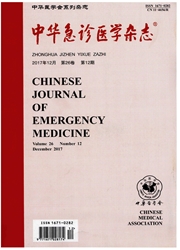

 中文摘要:
中文摘要:
目的 研究4℃盐水诱导的低温状态对猪心肺复苏成功后肝脏生化功能学、酶学以及形态学的影响.方法 将猪致室颤4 min后,给予标准心肺复苏,按随机数字表法将恢复自主循环(restoration of spontaneous circulation,ROSC)的动物分为低温组与常温组.低温组给予4 ℃盐水以1.33mL/(kg·min)的速度持续灌注22 min后以10 mL/(kg·h)的速度维持4 h;常温组给予常温盐水,灌注速度与低温组相同.同时监测血流动力学及血气变化,并分别于基础状态、复苏后10 min,2 h,4 h抽血检测血清丙氨酸转氨酶(alanine aminotransferase,ALT)、天冬氨酸转氨酶(aspartate aminotransferase,AST)和乳酸脱氢酶(lactate dehydrogenase,LDH),于复苏后24 h处死动物,取其肝脏组织检测Na^+-K^+-ATP酶、Ca^2+-ATP酶,并行普通病理学及电镜检查.结果 4 ℃盐水诱导的低温可使中心体温下降达1.5℃,在ROSC后心率、平均动脉压、心输出量和冠脉灌注压低温组较常温组无明显改变(P>0.05);氧摄取率较常温组明显降低(P<0.01).与常温组相比,ROSC后低温组血清AST,ALT和LDH上升的程 度较小;肝脏ATP酶活力低温组较常温组明显增高(P<0.05).与常温组相比,低温组病理细胞水肿、坏死程度轻,炎性细胞浸润少,线粒体结构完整.结论 心肺复苏后给予4 ℃盐水持续快速静脉泵入,可使基础体温在短时间内下降达1.5 ℃,能快速、简便地营造机体亚低温环境,维持心肺复苏后血流动力学、氧代谢稳定,对肝脏功能、酶学及形态学都有一定的保护作用.
 英文摘要:
英文摘要:
Objective To assess the effects of hypothermia induced by 4 ℃ normal saline (NS) on biochemical function, enzymology and morphology of liver in swine after the success of cardiopulmonary resuscitation (CPR) for cardiac arrest(CA). Method The swine were resuscitated with standard CPR 4 minutes after ventricular fibrillation(VF) ,and the survived swine were randomly(random number) divided into two groups. In hypothermia(LT) group (n = 5), swine were treated with continuous infusion of 4 ℃ NS at the speed of 1.33 mL/(kg·min) for 22 min, and then slow the speed to 10 mL/(kg·h) for 4 h. In normothermia (NT) group ( n= 5) swine were treated with the infusion of NS with room temperature instead of cryogenic NS at the same speed as the LT group. The hemodynamics and the changes of blood gas were monitored until 4 h after restoration of spontaneous circulation (ROSC), and blood samples were taken to detect serum alanine aminotransferase (ALT), aspartate aminotransferase (AST) and lactate dehydrogenase (LDH) before VF and 10 min, 2 h and 4 h after ROSC. All swine were sacrificed 24 hours after ROSC, and their liver tissues were taken away for detecting Na^+ -K ^+ -ATP enzyme and Ca^2+ -ATP enzyme as well as the histological changes under both light and electron microscopy. Results The heart rate, MAP, cardiac output(CO) and coronary perfusion pressure(CPP) of swine were stable in LT group ( P 〉 0.05). The AST, ALT and LDH increased in both groups but less in LT group. The hepatic ATP enzyme activity was much higher in LT group ( P 〈 0.05). Compared with the NT group, there were less cellularedema,necrosis or inflammatory cells infiltration, and better morphosis of mitochondria of livers found in swine of LT group. Conclusions The continuous administration of 4 ℃ NS after ROSC could quickly lower the core body temperature, and it could keep hemodynamics and oxygen metabolisms stable, protecting the biochemical function,enzymology a
 同期刊论文项目
同期刊论文项目
 同项目期刊论文
同项目期刊论文
 Effect of continuous compressions and 30:2 cardiopulmonary resuscitation on global ventilation/perfu
Effect of continuous compressions and 30:2 cardiopulmonary resuscitation on global ventilation/perfu Mild Hypothermia Attenuates Mitochondrial Oxidative Stress by Protecting Respiratory Enzymes and Upr
Mild Hypothermia Attenuates Mitochondrial Oxidative Stress by Protecting Respiratory Enzymes and Upr Cerebrospinal fluid biochemistry reflects effects of therapeutic hypothermia after cardiac arrest in
Cerebrospinal fluid biochemistry reflects effects of therapeutic hypothermia after cardiac arrest in Effect of rescue breathing during cardiopulmonary resuscitation on lung function after restoration o
Effect of rescue breathing during cardiopulmonary resuscitation on lung function after restoration o Load-distributing band improves ventilation and hemodynamics during resuscitation in a porcine model
Load-distributing band improves ventilation and hemodynamics during resuscitation in a porcine model 期刊信息
期刊信息
